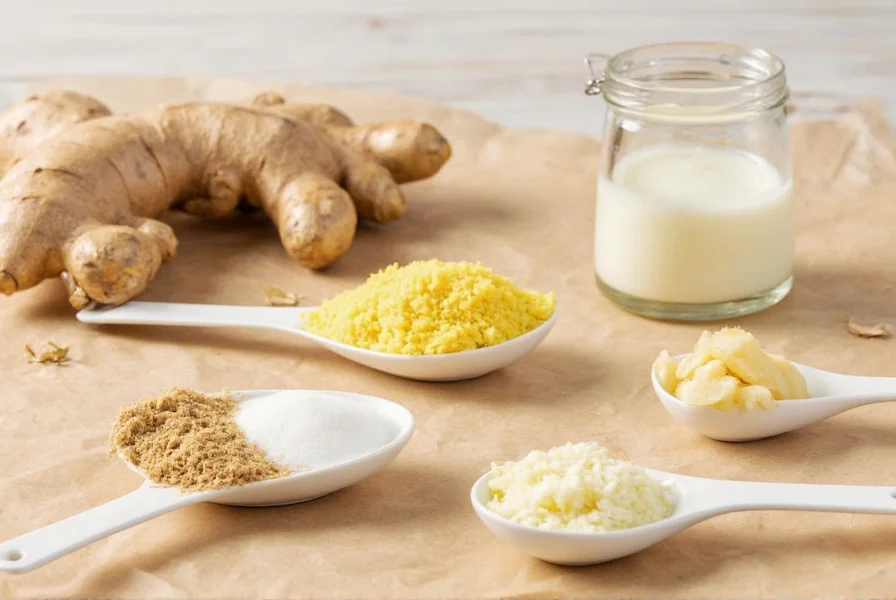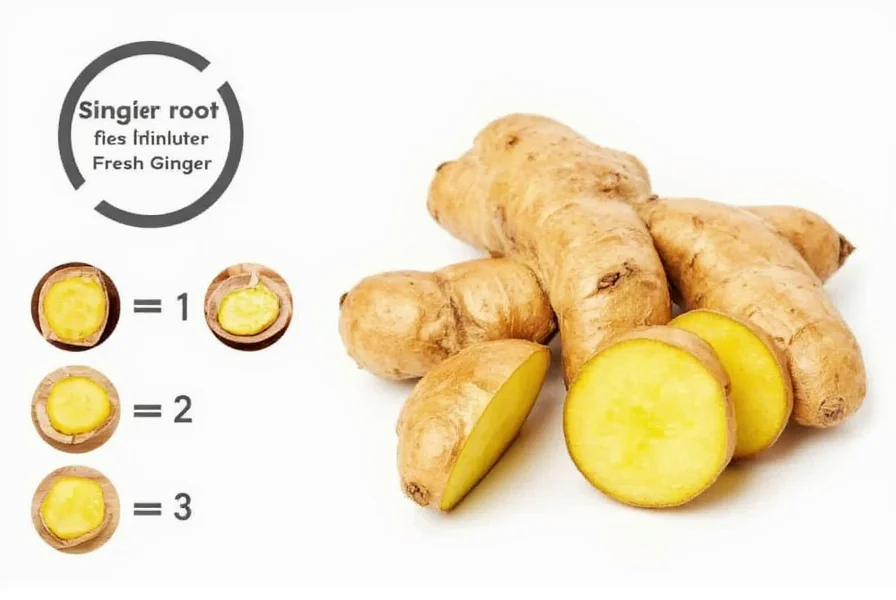The most effective substitutes for fresh ginger root are ground ginger (use 1/4 teaspoon ground for every 1 inch fresh ginger), galangal (for Southeast Asian dishes), and a combination of turmeric and lemon zest (for color and citrus notes). Ginger powder works well in baking, while pickled ginger provides a milder flavor for delicate dishes. The best substitute depends on your specific recipe and desired flavor profile.
Running out of fresh ginger root doesn't have to derail your cooking plans. Whether you're mid-recipe or planning your grocery list, knowing reliable alternatives keeps your culinary projects on track. This guide provides practical, tested substitutions that maintain the essence of ginger's distinctive flavor in various cooking applications.
Understanding Ginger's Unique Flavor Profile
Fresh ginger root offers a complex flavor profile—spicy, citrusy, slightly sweet, and warmly aromatic. Its pungency comes from gingerol, which transforms when heated or dried. Recognizing these characteristics helps select appropriate substitutes that preserve your dish's intended flavor balance.
Top 7 Substitutes for Fresh Ginger Root
1. Ground Ginger (Best for Baking and Dry Rubs)
Ground ginger works well in baked goods, spice blends, and dry rubs where moisture content isn't critical. Since it's more concentrated, use a 1:4 ratio—1/4 teaspoon ground ginger replaces 1 inch of fresh ginger root. Remember that ground ginger lacks the bright, citrus notes of fresh ginger, so adding a pinch of lemon zest can enhance the flavor profile when substituting in non-baked dishes.
2. Galangal (Ideal for Southeast Asian Cuisine)
Often called 'Thai ginger,' galangal shares ginger's rhizome structure but offers a sharper, more floral flavor with hints of pine and citrus. Use equal amounts of galangal for fresh ginger in Thai, Indonesian, and Malaysian dishes. Note that galangal is harder and typically requires grating or very fine slicing for proper incorporation.
3. Turmeric with Lemon Zest (Color and Earthy Flavor)
When you need ginger's golden color without intense heat, combine 1/2 teaspoon turmeric with 1 teaspoon lemon zest for every 1 inch of fresh ginger. This substitution works well in curries, rice dishes, and soups where appearance matters. Turmeric provides the color while lemon zest mimics ginger's citrus undertones.
4. Pickled Ginger (Gari) (Milder Option for Delicate Dishes)
Commonly served with sushi, pickled ginger offers a milder, sweeter ginger flavor. Use 2 tablespoons of drained, finely minced pickled ginger to replace 1 inch fresh ginger. This substitute works particularly well in salad dressings, seafood dishes, and light sauces where a pronounced ginger kick would overwhelm other flavors.
5. Ginger Paste (Convenient Prepared Option)
Found in tubes near fresh produce, ginger paste provides consistent flavor without grating. Substitute 1/2 teaspoon ginger paste for 1 inch fresh ginger. The paste often contains citric acid as a preservative, which can slightly alter flavor in delicate dishes, so taste as you go when substituting.
6. Allspice and Clove Combination (For Baking Applications)
In baked goods where ginger's warmth matters more than its distinct flavor, combine 1/8 teaspoon allspice with a pinch of ground cloves to replace 1 inch fresh ginger. This substitution works particularly well in gingerbread, spice cakes, and holiday cookies where multiple warm spices blend together.
7. Cardamom and Black Pepper (For Complex Spice Profiles)
When creating Middle Eastern or Indian dishes, substitute 1/4 teaspoon ground cardamom plus a pinch of black pepper for 1 inch fresh ginger. This combination provides the warmth and complexity ginger contributes to spice blends like garam masala without the citrus notes.
| Substitute | Ratio (vs. 1 inch fresh ginger) | Best For | Flavor Notes |
|---|---|---|---|
| Ground ginger | 1/4 teaspoon | Baking, dry rubs | Milder, earthier, less citrusy |
| Galangal | 1:1 | Thai, Indonesian dishes | Sharper, more floral, pine notes |
| Turmeric + lemon zest | 1/2 tsp turmeric + 1 tsp zest | Curries, rice dishes | Provides color, milder heat |
| Pickled ginger (gari) | 2 tbsp minced | Salad dressings, seafood | Sweeter, milder, vinegary note |
| Ginger paste | 1/2 teaspoon | Quick meal preparation | Convenient, consistent flavor |
When to Use Which Ginger Substitute
Choosing the right substitute depends on your specific recipe and desired outcome:
- Asian stir-fries and soups: Galangal provides the closest flavor match for Thai and Indonesian dishes, while ground ginger works better for Chinese recipes where ginger's role is more background than prominent
- Baking projects: Ground ginger combined with a pinch of allspice creates the warm spice profile needed for gingerbread and spice cakes
- Smoothies and beverages: Ginger paste or a small amount of pickled ginger blended with citrus works better than dried alternatives
- Marinades: Fresh alternatives like galangal or ginger paste incorporate better than dried options
- Delicate sauces: Pickled ginger or a turmeric-lemon combination prevents overwhelming other flavors
Avoiding Common Substitution Mistakes
Many home cooks make these errors when substituting ginger:
- Using equal amounts of ground ginger: Dried ginger is more concentrated—always use 1/4 the amount of ground ginger compared to fresh
- Adding substitutes too late: Dried spices need time to bloom in oil or liquid—add them early in the cooking process
- Ignoring flavor balance: When using turmeric as a color substitute, add lemon zest to compensate for missing citrus notes
- Overcompensating: Start with less substitute than you think you need—you can always add more but can't remove excess
Storing Ginger Substitutes Properly
Maximize shelf life and flavor potency of your ginger alternatives:
- Ground ginger and other dried spices maintain potency for 6-12 months when stored in airtight containers away from light and heat
- Ginger paste in tubes lasts 3-4 weeks refrigerated after opening
- Pickled ginger stays fresh for 2-3 months refrigerated after opening
- Freeze ginger paste in ice cube trays for portion-controlled use in future recipes
Creating Your Own Ginger Substitute Blend
For the most versatile ginger alternative, create a homemade blend:
- Mix 2 tablespoons ground ginger, 1 tablespoon ground turmeric, and 1 teaspoon lemon zest powder
- Store in an airtight container away from light
- Use 1/4 teaspoon of this blend to replace 1 inch fresh ginger
- Add a pinch of black pepper to enhance turmeric's bioavailability
This custom blend works particularly well in curries, soups, and stews where ginger's warming properties matter more than its distinct flavor. The combination captures ginger's heat, turmeric provides color, and lemon zest mimics the citrus notes missing in dried ginger.

Final Considerations for Successful Substitution
When substituting for fresh ginger root, consider these final tips for best results:
- Taste as you cook—adjust seasoning after adding your ginger substitute
- For recipes where ginger is the star (like ginger tea), no substitute fully replicates fresh ginger's bright flavor
- When making substitutions in fermented foods, remember that fresh ginger contributes to the fermentation process
- Consider your audience's heat tolerance—some substitutes like galangal can be significantly hotter than fresh ginger
Frequently Asked Questions
Can I use ground ginger instead of fresh ginger in stir-fry?
Yes, but use only 1/4 teaspoon ground ginger for every 1 inch of fresh ginger called for. Add it early in the cooking process to allow the flavor to bloom in the oil, and consider adding a pinch of lemon zest to replicate fresh ginger's citrus notes. Ground ginger works better in Chinese stir-fries than Thai or Vietnamese dishes where fresh ginger's bright flavor is more prominent.
What's the best ginger substitute for making ginger tea?
For ginger tea, fresh ginger provides the best flavor, but if unavailable, ginger paste (1/2 teaspoon per cup) or dried ginger slices (1/2 teaspoon per cup) work reasonably well. Avoid ground ginger as it can become bitter when steeped. Adding a slice of fresh lemon or a pinch of lemon zest enhances the flavor profile when substituting.
How do I substitute ginger in baking recipes?
In baking, use 1/4 teaspoon ground ginger for every 1 inch fresh ginger. For better flavor complexity, combine 1/8 teaspoon ground ginger with a pinch of allspice and cloves. In recipes like gingerbread where ginger is prominent, consider adding 1/2 teaspoon molasses per substitution to enhance the warm spice notes.
Is galangal a good substitute for fresh ginger in all recipes?
Galangal works well as a 1:1 substitute for fresh ginger in Southeast Asian dishes like Thai curries and Indonesian sambals, but it's not ideal for all recipes. Galangal has a sharper, more floral flavor with pine notes that differs from ginger's citrusy warmth. It's too strong for delicate dishes, baking, or Western recipes where ginger plays a supporting role rather than a starring one.
Can I use turmeric alone as a ginger substitute?
Turmeric alone makes a poor ginger substitute as it lacks ginger's characteristic heat and citrus notes, providing only color. For better results, combine 1/2 teaspoon turmeric with 1 teaspoon lemon zest to replace 1 inch fresh ginger. This combination works best in curries and rice dishes where appearance matters more than ginger's distinct flavor profile.











 浙公网安备
33010002000092号
浙公网安备
33010002000092号 浙B2-20120091-4
浙B2-20120091-4